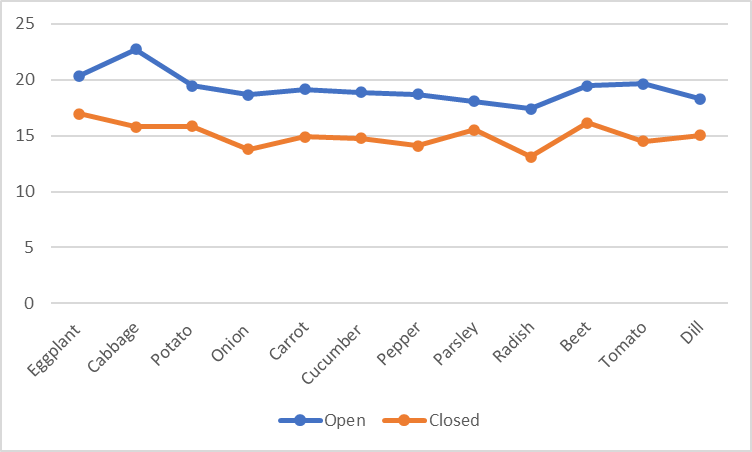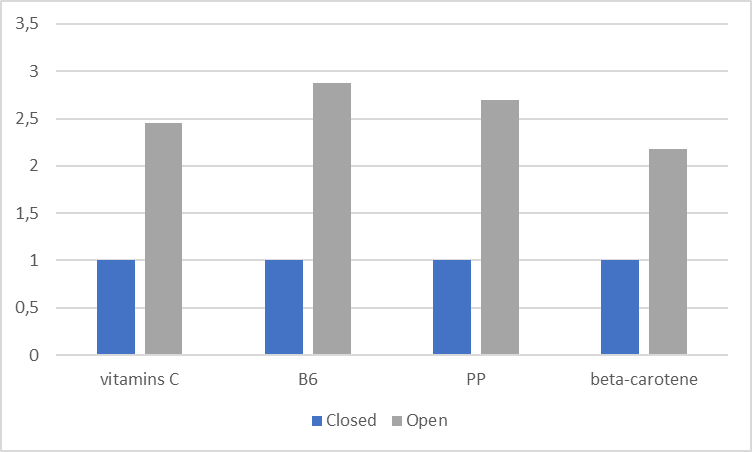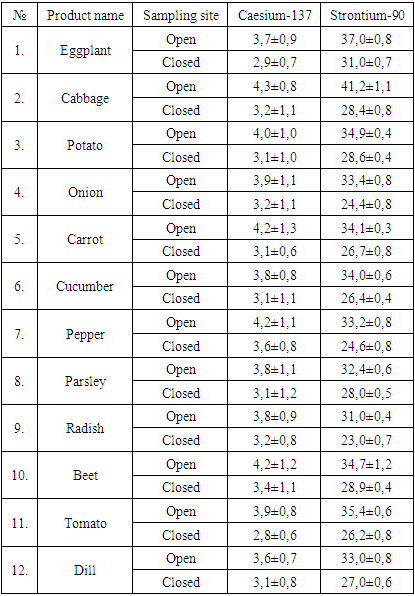-
Paper Information
- Next Paper
- Paper Submission
-
Journal Information
- About This Journal
- Editorial Board
- Current Issue
- Archive
- Author Guidelines
- Contact Us
American Journal of Medicine and Medical Sciences
p-ISSN: 2165-901X e-ISSN: 2165-9036
2025; 15(3): 653-656
doi:10.5923/j.ajmms.20251503.35
Received: Feb. 19, 2025; Accepted: Mar. 9, 2025; Published: Mar. 13, 2025

Assessment of the Biological Values of Agricultural Products Grown in Open and Closed (Protected) Styles About the Radiation Norm
Kodirov Dilmurod1, Israilova Gulida2, Khudayberganov Anatoliy3
1Assistant, Department of Hygiene and Radiation Safety, Center for the development of Professional Qualifications of Medical Personnel of the Ministry of Health of the Republic of Uzbekistan
2Associate Professor, Department of Hygiene and Radiation Safety, Center for the Development of Professional Qualifications of Medical Personnel of the Ministry of Health of the Republic of Uzbekistan
3Professor, Department of Hygiene and Radiation Safety, Center for the Development of Professional Qualifications of Medical Personnel of the Ministry of Health of the Republic of Uzbekistan
Correspondence to: Kodirov Dilmurod, Assistant, Department of Hygiene and Radiation Safety, Center for the development of Professional Qualifications of Medical Personnel of the Ministry of Health of the Republic of Uzbekistan.
| Email: |  |
Copyright © 2025 The Author(s). Published by Scientific & Academic Publishing.
This work is licensed under the Creative Commons Attribution International License (CC BY).
http://creativecommons.org/licenses/by/4.0/

The purpose of the study is to provide a hygienic assessment of agricultural food products of the Republic of Karakalpakstan with checked radiological and biological indicators in an open and closed (protected) way. To do this, more than 600 samples from the Beruniy District of the Republic of Karakalpakstan, the city of Nukus, Kongirat, and Moynok districts were examined for cesium-137, strontium-90, vitamin C, B group vitamins, vitamin PP and betta-carotene. The examination results were provoked by the fact that the bloodthirsty and furry fogsid Caesium-137 and strontium-90 were relatively high. At the same time, it should be noted that indoor food cultivation when grown in an open and closed (protected) way is more effective than the open method [1-2].
Keywords: Open and closed method, Vitamins, Strontium-90, Caesium-137
Cite this paper: Kodirov Dilmurod, Israilova Gulida, Khudayberganov Anatoliy, Assessment of the Biological Values of Agricultural Products Grown in Open and Closed (Protected) Styles About the Radiation Norm, American Journal of Medicine and Medical Sciences, Vol. 15 No. 3, 2025, pp. 653-656. doi: 10.5923/j.ajmms.20251503.35.
Article Outline
1. Introduction
- Currently, as a result of increased contamination of food content with radioactive strontium-90 and Caesium-137, it is necessary to constantly conduct inspection control of these radionuclides in all deities. Therefore, ensuring the radiation safety of agricultural food is one of the main measures. Especially in the countries of Central Asia, in particular in Uzbekistan, things are a little slow [3].Despite numerous studies and publications on the beneficial aspects of food in the Republic of Karakalpakstan during the early developing period, ensuring the radiation safety of agricultural products in the Aral Sea region remains completely unresolved [4].Radioactive substances enter the body through the lungs with breathing air, through the gastrointestinal tract with Charged Water and food, through wounds and scratches on the skin, and even through intact skin [5].Radioisotopes are distributed differently in the body. Strontium, barium, and radium - accumulate in the skeleton; plutonium - in the liver, spleen, and bone marrow; cesium - in the muscles; iodine radioisotopes - in the thyroid gland. After entering the body, radionuclides remain there for several days to tens of years. Some nutrients have a prophylactic radioprotective effect and have the property of removing radionuclides by binding them out of the body. Such substances include pectin. The most popular sources of pectin are apples, marshmallows, and marmalade. In addition to pectin, lipopolysaccharides present in grapes and tea leaves, melanin, red and yellow vegetables, and bioflavonoids contained in fruits (tomatoes, Tangerines, Hawthorn), which are found mainly in dark grape varieties, have a radioprotective effect. While radioactive elements cause fragility of the walls of blood vessels, vitamins of Group B, C, and PP restore their normal elasticity and permeability, the same effect is exerted by the phenolic compounds of plants, which are present in large quantities in propolis [6-7].
2. The Purpose of the Study
- To study of hygienic measures for the protection of agricultural products from radioactive substances of the Republic of Karakalpakstan and substantiate the criteria for points of control over the risk factors of contamination of agricultural products.
3. Materials and Methods
- The research was carried out at the Center for the Development of professional qualifications of medical personnel, the Department of Radiological Laboratory of the Republic of Karakalpakstan for sanitary and epidemiological tranquility and public health, as well as in regional laboratories.Agricultural products in the Republic of Karakalpakstan (cereals, pulses, crops, mold vegetables, animal meat of various types) radiological indicators and statements of laboratory tests of Physico-Chemical and raw materials and finished products are research objects. In total, more than 587 questionnaires were studied, 110 laboratory research statements on raw materials and finished products in 14 large and small agricultural farms in Karakalpakstan.In the process of work, critical points were identified and analyzed, taking into account the features of the technological process, the equipment used, the quality of raw materials, product recipes, and the climatic features of the country [8-9].To fulfill the goals and objectives set, a survey questionnaire, a sanitary-hygienic laboratory test, and statistical methods were used.
4. Results and Discussions
- The main argument in the implementation of the Basic Rules of its scientific work, this chapter shows comparative safety indicators on the types of agricultural products, depending on the conditions of cultivation. It should be noted that in addition to greenhouse farming in Karakalpakstan, a closed form is often used to protect against spring frosts and agriculture in the form of open land. Caesium-137 3.7±0.9 Bk/kg and Strontium-90 37.0±0.8 Bk/kg in white cabbage samples, Caesium-137 3.9±0.8 Bk/kg in tomato samples, and Strontium-90 35.4±0.6 Bk/kg were found to be the largest radioisotope contamination (Table 1). Cesium-137 in potatoes was found to be 4.0±1.0 Bk/kg in open farming and 3.1±1.0 in closed farming; Caesium-137 in carrots was found to be 4.2±1.3 Bk/kg in open agriculture and 3.1±0.6 in closed farming (Figure 1). None of the samples of agricultural products obtained in the open and closed farming method were found to be higher than the radiation indicators adopted by sanitation standards and regulations 0366-19 of the Republic of Uzbekistan. The reliable effect of farming conditions on radiation safety indicators of agricultural products in both open and closed regimes has not been established. This condition is explained by the penetration of radionuclides through irrigation waters and soils, and a lack of influence through the atmosphere. Reliably high concentrations of harmful substances (cadmium, lead) were found in products grown in open farming conditions, indicating the risk of contamination of Karakalpakstan agricultural products through atmospheric air. This is due to sandstorms and dust that occasionally fall into agricultural fields.
|
 | Figure 1. Radionuclides in products grown in open and closed places |
 | Figure 2. The average relative index of vitamins |
5. Conclusions
- 1. An assessment of the actual state of contamination of agricultural products (cereals, pulses, root crops, mold, vegetables, meat of various animals) indicates compliance with the permissible norms at 0366-19 sanitation standards and regulations.2. When the load of radioactive elements at the expense of agricultural products in the food diet of the inhabitants of Karakalpakstan is calculated, it indicates a relatively high dose load throughout the Moynok and Kongirat districts. This is due to the natural background of the Aral Sea – a diverse industrial complex in the districts of Moynok and Kongirat.3. The reliable effect of farming conditions on radiation safety indicators of agricultural products in both open and closed regimes has not been established. This condition is explained by the penetration of radionuclides through irrigation waters and soils, and a lack of influence through the atmosphere. 4. The development of risk assessment criteria in ecologically unfavorable farming zones indicates the presence of important points when choosing a farming method.
 Abstract
Abstract Reference
Reference Full-Text PDF
Full-Text PDF Full-text HTML
Full-text HTML